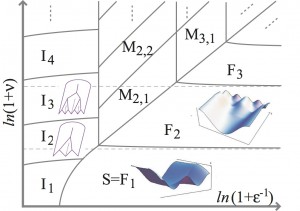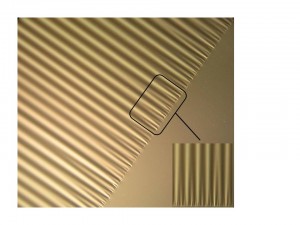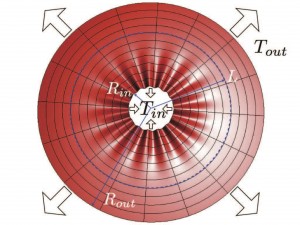 The question underlying pattern formation theory is how a complex shape emerges under featureless forces and constraints. The basic paradigm here relies on a fundamental principle in modern condensed matter theory: A spontaneous breaking of continuos symmetry.
The question underlying pattern formation theory is how a complex shape emerges under featureless forces and constraints. The basic paradigm here relies on a fundamental principle in modern condensed matter theory: A spontaneous breaking of continuos symmetry.
 In a previous work we employed this concept to address the origins for morphological complexity in thin sheets through a primary example of simple-yet-complex shape: The “elastic curtain”. An illustration of the system is in the top figure. The basic question here is how the typical hierarchical (multi-scale) shape of curtains (e.g. in your shower) emerges spontaneously by confining one edge (the curtain rod, x=0 in the figure). A central result of our analysis is the prediction of a novel series of elastic “period fissioning” instabilities, that govern the pattern when sufficiently large tension is exerted (along x). Furthermore, this analysis led us to conjecture the existence of a surprisingly rich phase diagram for this problem (bottom figure), in which all patterns are classified according to two parameters: A mechanical one (epsilon – the compression-to-tension ratio), and a geometric one (nu – the wavelength contrast along the tension direction). Later on, these parameters were recognized as particular realization of universal morphologically-relevant parameters, termed bendability, confinement, and substrate-stiffness (work in progress). In this phase diagram for the curtain problem, the predicted phases consist of hierarchical patterns of distinct types: Smooth “period fissioning” cascades, with n generations of wrinkles (Fn), “Irregular” shapes, composed of k generations of sharp folds (Ik), and “Mixed” patterns, in which n generations of smooth wrinkles “coexist” with k generations of sharp folds (Mn,k).
In a previous work we employed this concept to address the origins for morphological complexity in thin sheets through a primary example of simple-yet-complex shape: The “elastic curtain”. An illustration of the system is in the top figure. The basic question here is how the typical hierarchical (multi-scale) shape of curtains (e.g. in your shower) emerges spontaneously by confining one edge (the curtain rod, x=0 in the figure). A central result of our analysis is the prediction of a novel series of elastic “period fissioning” instabilities, that govern the pattern when sufficiently large tension is exerted (along x). Furthermore, this analysis led us to conjecture the existence of a surprisingly rich phase diagram for this problem (bottom figure), in which all patterns are classified according to two parameters: A mechanical one (epsilon – the compression-to-tension ratio), and a geometric one (nu – the wavelength contrast along the tension direction). Later on, these parameters were recognized as particular realization of universal morphologically-relevant parameters, termed bendability, confinement, and substrate-stiffness (work in progress). In this phase diagram for the curtain problem, the predicted phases consist of hierarchical patterns of distinct types: Smooth “period fissioning” cascades, with n generations of wrinkles (Fn), “Irregular” shapes, composed of k generations of sharp folds (Ik), and “Mixed” patterns, in which n generations of smooth wrinkles “coexist” with k generations of sharp folds (Mn,k).
This work, by Benny Davidovitch, was published in Phys.Rev.E. 80 025202 (2009).
It was inspired by (and provided the theoretical basis for) the analysis of smooth cascades of floating ultrathin sheets – an experiment by our colleagues at UMass, Amherst.
Of interest is also a recent experimental paper on the universal nature of the curtain problem by a group of researchers from Mons, Paris, MIT and Riverside.



 Wrinkling patterns are ubiquitous in elastic sheets of various types: plastic wraps, metallic foils, human skins, or plant leaves. Yet, the strong dependence of these patterns on physical parameters, such as the thickness of the sheet and the stretching forces, has not been well understood. In a recent theoretical work we addressed this problem. Focusing on the “simplest yet nontrivial” set-up that gives rise to wrinkles of finite size(top figure), we identified
Wrinkling patterns are ubiquitous in elastic sheets of various types: plastic wraps, metallic foils, human skins, or plant leaves. Yet, the strong dependence of these patterns on physical parameters, such as the thickness of the sheet and the stretching forces, has not been well understood. In a recent theoretical work we addressed this problem. Focusing on the “simplest yet nontrivial” set-up that gives rise to wrinkles of finite size(top figure), we identified 